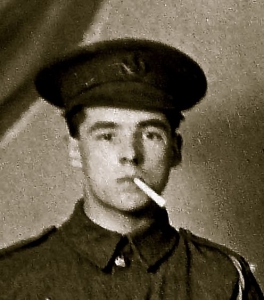JOHN NOWELL 1891–1918

Photograph from the Cutler collection
Born 1891 in Radcliffe on Trent
(Always known as Jack)
Baptised 10th May 1891 St Mary’s Church, Radcliffe on Trent
Killed in action 4th November 1918 during the attack at Sebourg, Battle of the Sambre, France. Age 27.
Burial: Sebourg British Cemetery A 33.
Commemorated on Radcliffe on Trent War Memorial
1901 Census
Age 9 living on Bailey Lane, Radcliffe on Trent, with father George 32, a joiner, mother Sarah 34 and sister Lilian 8.
1911 Census
Age 19 living at Ragdale Hall, Ragdale, Hoby, Leics. He is employed as a domestic groom.
Military Service
Rank: Sergeant
Service Number: 266072
Military Unit: 9th Battalion, The Sherwood Foresters, 33rd Brigade, 11th (Northern) Division
Theatre of War: France and Flanders, date of entry 26.2.17
John Nowell was initially in the 2/7th Sherwood Foresters so would have been a member of the Territorial Forces. He probably moved to 9th Battalion in early 1918 when the 2/7th was disbanded. It is likely that he served in Ireland from April 1916 until early 1917. His service record has not been found.
From the Nottinghamshire Great War Roll of Honour, added by John Morse:
“John Nowell first served with the 2/7th battalion and entered theatre of war – France, 26/2/17. Prior to that the 2/7th had been in Ireland.”
Son of George and Sarah Ann Nowell, Holme Road, Radcliffe on Trent
From the Sherwood Foresters Roll:
‘Morse research document (held in the Regimental Archives) into 9th Bn shows (he) served with 2/7th Bn then with the 9th Bn (could have served in Irish rebellion of 1916 with 2/7th)’
Medals Awarded: British War and Victory
Go to WWI Timeline to see how this man’s death is part of the wider story of the war.
John Nowell was killed on 4th November, 1918.
From the Nottinghamshire Great War Roll of Honour:
‘John Nowell first served with the 2/7th battalion and entered theatre of war – France, 26.2.17. Prior to that the 2/7th had been in Ireland. He probably moved to the 9th battalion in early 1918 when the army re-organisation was taking place. The battalion had much success during the last 100 days of the war and 4 November 1918 would be their last battle. It also proved to be a costly one with over 50 men killed and many wounded. The battalion inflicted a large number of casualties on the enemy, capturing 30 men and also 10 machine guns. John was one of those to die and he is buried in the small battlefield cemetery overlooking Sebourg. Thirty five of the fifty six graves in the Sebourg British Cemetery are 9th battalion men’.
From the War Diaries of the 9th Bn, The Sherwood Foresters, November 1918
SEBOURG November 4th 1918
At 05.30 the Battn. without Artillery preparation, continue the pursuit of the enemy and capture SEBOURG (Sheet 51) overcoming the slight opposition met with in the village, inflicting a number of casualties on the enemy.
In attempting to capture the high ground E. of SEBOURG (A.21 and 27), “C”, and “D” Coys. met with strong opposition from M.G. fire and the enemy attempted a local counter attack which only resulted in our foremost coys. having to fall back slightly to conform with Units on the flanks. See Appex. No.73.
During the counter attack, which was delivered from the Ridge A.2l and 27. two 4.5 Hows. attached to the Battn. engaged the enemy with open sights and inflicted casualties. (These Hows. fired from Bn. H.e. F.30. sheet 51A, 2000 yds. from the enemy). The leading coys. “C” and “D” suffered fairly heavily during these operations, chiefly from M.G. fire and the following officers wounded:-
Capt. F.S. Suffolk, O/C “D” Coy, 2/Lt. Rigden, “D” Coy, 2/Lt.W. Francis, “D” Coy, 2/Lt. Haynes, “D” Coy, Lt. C. Wilmot, O/C “C” Coy, 2/Lt. J. B. Russell, “C’, Coy, 2/Lt. F. Parker, M.C., “C” Coy, 2/Lt. H. M. Crowther. The latter remained on duty, taking command of “C” and “D” Coys.
The extent of the Advance was 4000 yds. and Bn. H.e. were as follows:-
1st Stage – F.29.d.0.6. E. of CURGIES, 2nd ” F.29.b.centl. (Tank), 3rd ” SEBOURG F.30. (Ref.Sheet 51A.) See Map No.3.
Heavy casualties were inflicted on the enemy by our Lewis Gun and Rifle fire both in the village and on the Ridge. 30 Prisoners were captured, 3 Tanks recaptured, 10 M.G’s captured.
Orders were issued during the afternoon for an attack to be made to gain ridge with Artillery Support Zero to be 1700, but this was postponed and the Battn. dug in for the night on the Eastern outskirts of SEBOURG . App.74. Map No.3
November 5th. The attack postponed yesterday was carried out successfully this morning. Zero being 05.30 when the Artillery opened a creeping barrage.
Little opposition was met with and all objectives were gained by 07.05. App.75 “A” and “8” Coys. who led the attack established Posts, forward of the objective in A.2l and 27 . Map No.3. During the morning the Supporting Battn. (6th Lincs.) followed by the 7th S. Staffs. passed thro’ the Battn. which withdrew to Billets in SEBOURG and remained in Reserve. Enemy retaliation for our barrage was very feeble.
The B.G.C. (Battle Group Commander?) sends his congratulations to the battery for work done in operations on 3rd, 4th and 5th inst.
Medals Awarded: British War and Victory
Obituary
From Nottingham Evening Post, Nov 28 1918:
Reasons for inclusion on the Radcliffe on Trent Roll of Honour
Born and lived in Radcliffe on Trent with parents and siblings.
Sebourg British Cemetery, France

